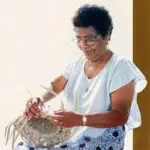Lucia Fernandez Torres
Master weaver
Lucia Fernandez Torres (1933 – 2007) was a recognized Master of the traditional folk art of weaving. An advocate of the importance of cultural traditions, she shared her skills with others interested in learning how to weave. Her crafts have been displayed locally and in regional exhibits throughout the Pacific.
Torres was born in 1933 and raised in the village of Yo’ña (Yona). At the age of eight, she learned to weave from her grandmother, Josefa Quichocho, and mother, Mercedes Fernandez. Torres recalled in a 1993 interview that, during the Japanese Occupation of Guam in World War II:
“The Japanese put me under a coconut tree and had me weave with my brother.”
Torres’ weaving skills saved her from the usual jobs assigned to children under Japanese rule. During World War II, while their peers harvested vegetables, she and her brother, Francisco, made baskets for the Japanese to carry their produce. After the war, Torres was one of the first weavers to sell her work to American military families who lived in the island.
Torres’ weaving mastery was a tradition passed down through the generations. Recognized as an accomplished weaver since her youth, she both displayed and demonstrated her skill and techniques in weaving pandanus leaf and coconut palm leaf items. Torres encouraged the importance of perpetuating the unique weaving style of the CHamorus/Chamorros and the basic CHamoru basket weave, noted among Pacific islander societies as having considerable strength with its double rim.
Pandanus weaving of miniature traditional items became Torres’s trademark, along with her special skill for teaching weaving techniques in a clear, well-disciplined style to her numerous apprentices. She conducted residencies extensively throughout Guam’s schools since 1977, as well as supervised apprenticeship weaving programs to effectively continue the art form. Additionally, she taught the craft to all of her five children, who often helped her demonstrate, teach and produce special orders.
Torres was especially busy, displaying and demonstrating her work throughout the island, at various CHamoru Week activities and cultural events like the Guam Micronesian Island Fair. She also demonstrated Guam’s traditional CHamoru weaving heritage as a representative at the 4th, 5th, 6th and 7th Festival of Pacific Arts, respectively in Tahiti, Australia, the Cook Islands, and American Samoa. She also participated in the yearly CHamoru Cultural Fair in California since 1989.
Other notable displays of Torres’ work included the inauguration of President Carter in 1976, and the presentation of 30 hats and baskets to President Nixon’s delegation at their 1972 visit in Guam during their historic trip to Vietnam. Torres made hats and baskets for the International Mother Daughter Pageant hosted in Guam in 1988, and 150 baskets for Pope John Paul II’s historic visit to the island in 1981. Countless wedding receptions were decorated with Torres’ weaving throughout the years, including Governor Paul Calvo’s daughter’s wedding at Government House during his term in the early 1980s. The Torres family Christmas tree also was decorated with woven miniatures and “katupat” rice holders. Instead of rice, the little woven triangular boxes contained money gifts for her children.
Weaving, or more specifically plaiting, of coconut leaf or pandanus leaf has been practiced by the indigenous CHamorus since pre-contact times. Early explorers described the baskets, hats, and other utilitarian objects that were used by the native people of the Mariana Islands. Conical hats depicted in early etchings were eventually replaced with Mexican-influenced sombreros or coconut leaf brimmed hats. Sleeping mats (guafak), lunch-carrying bags (kostat tengguang), rice cooked in individual serving-size woven coconut leaf bags (katupat), fishing and other carrying baskets (guagua’), and fans (gueha), however, have survived and evolved through the years.
Freshly-picked coconut leaves are used to make carrying baskets, hats for shade, and other items needed immediately. On the other hand, pandanus (akgak, or Pandanus tectorius) is a more durable, long-lasting fiber that requires processing by removing the sawtooth-like thorny edge and center of each leaf, flexing the leaf by repeated rolling, then unrolling and drying in the sun for several days. The leaves may be further bleached by boiling in water or colored by adding dyes to the boiling water. The weaver uses a flat, elongated triangular tool called a si’i, whereby the short edge is sharpened to cut the leaf and the pointed end is used to poke into the fibrous leaf and strip it into smaller widths for finer weaving jobs.
Torres’ son, Enrique, recalled how his mother taught him and his siblings to weave until they had it memorized. “We had to un-weave what we just wove and do it again until we had the skill down pat,” he said. Violet Castro, who apprenticed under Torres, said that she learned more from her about weaving than from her parents and grandparents.
“She taught me whatever she could, from basic to contemporary [weaving styles]. She was very outspoken. She really made you understand what you were learning…She left a really strong legacy. Her children can weave and a lot of the apprentices that she had were really passing it on. So there’s no way she’ll be forgotten.”
Torres was among the first to be awarded the Master of Traditional Arts Title in 1989. Her woven items were part of a professionally-curated regional touring exhibit, “Island Treasures,” in 2000, which featured works by master practitioners in Guam, Northern Marianas, and American Samoa, sponsored by the Consortium for Pacific Arts and Cultures (CPAC) with assistance from the National Endowment for the Arts in Washington, DC. Her work was documented through photos and paintings by Ron Castro throughout the 1990s and until her death in 2007.
She was included in a poster series that featured Traditional Artists of Guam created by Castro. The posters were later published in a book by the Guam Council on the Arts and Humanities Agency, A Journey with the Masters of Chamorro Tradition, in 2001.
Torres is the recipient of numerous other local and regional awards including the 1997 Maga’lahi Art Award in Special Recognition for Lifetime Cultural Contributions.
For further reading
Castro, Ron J. “Master Weaver Tan Lucia Torres.” Traditional Masters Poster Series. Hagåtña: Guam Council on the Arts and Humanities Agency, 1996.
–––. “Master Weaver Tan Lucia Torres.” In A Journey with the Masters of Chamorro Tradition. Hagåtña: Guam Council on the Arts and Humanities Agency, 2000.
Chavez, Yong B. “Treasured Craft: Exhibit showcases works of master artists from Guam, American Samoa and CNMI.” Pacific Daily News, 21 January 2000.
Flores, Judy S. Guam Folk Arts Directory: A Resource Book of the Traditional Arts and Artists of Guam. Hagåtña: Guam Council on the Arts and Humanities Agency, 1989.
Godlewski, Stephanie. “Master weaver remembered.” Pacific Daily News, 11 September 2007.
Wytowich, Judy M. “Her art keeps her traveling the wide Pacific: Lucia Torres, Weaver.” Islander Magazine, Pacific Daily News, 17 January 1993.




